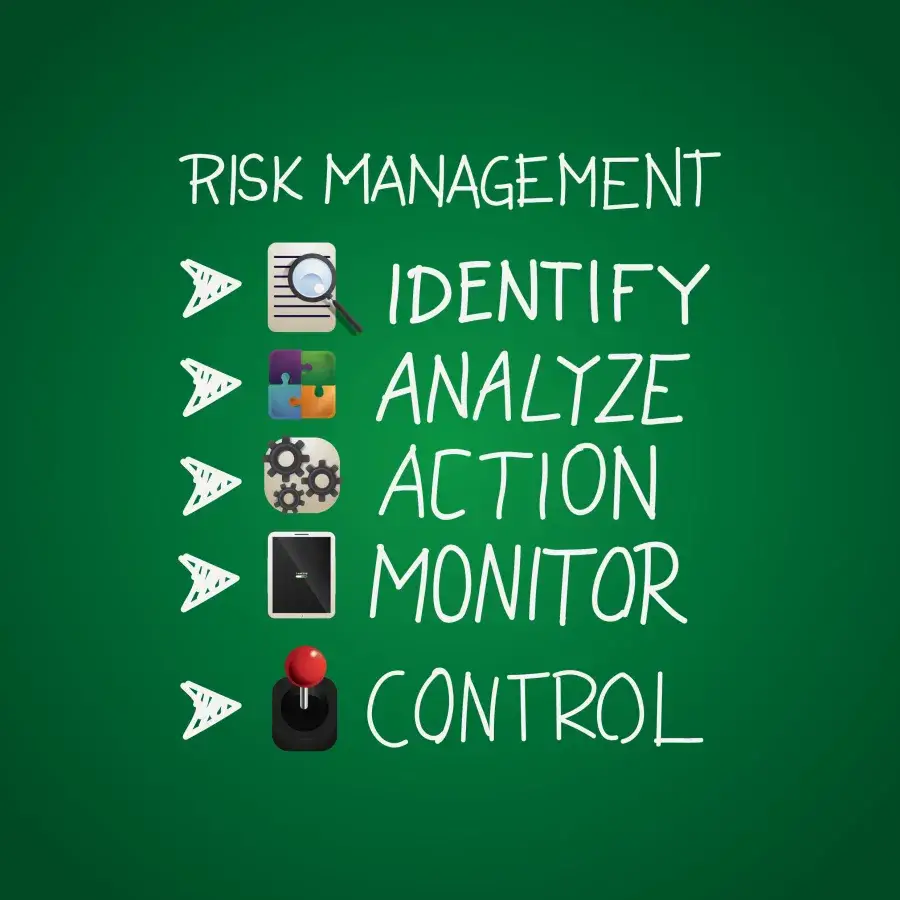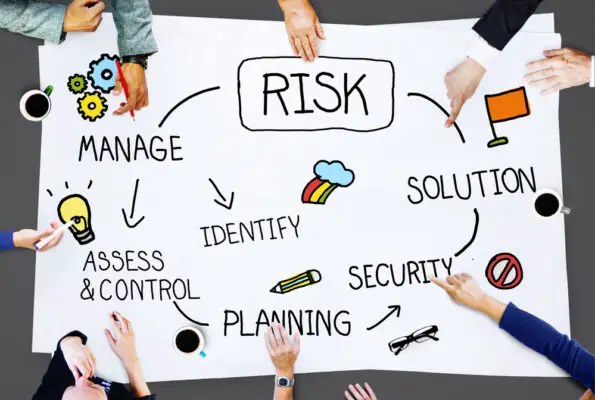The risk management process is a systematic way of identifying, assessing, responding to, and monitoring risk factors. It provides an organized framework for managing potential losses that can affect your company’s business operations and financial position. Doing so ensures the protection of assets and helps you stay competitive in today’s market.
The five steps of the risk management process are identification, assessment, response planning, implementation, and monitoring/controls (internal). These steps serve as a roadmap to help you manage risks successfully while protecting your bottom line.
The risk management process is a five-step process that helps individuals and organizations reduce the risks of failure. Risk management is essentially about identifying and reducing or eliminating potential threats to your enterprise.
Holistic view to have a positive experience for a project manager to manage risk is having a risk management solution to document the basic steps of the subject and create examples that answer the sign of slowly drop and rise sharply movement of events.
The first step in the risk management process is to identify possible hazards and vulnerabilities. The second step is an assessment which involves determining how likely it will be for an event to happen, as well as how much damage it could cause if it does happen.
The third step in the risk management process is mitigation which means taking steps to lessen the risks of a hazard happening by implementing certain safeguards such as safety equipment, training programs, etc. The fourth step in this five-step process deals with control which entails deciding what should be done if a threat becomes reality.
The role of the Risk Manager in an organization is to ensure that risk management procedures are followed correctly and that they are not violated. A project implementation team member will be able to comprehend and manage project risks, thus helping manage the enterprise’s risk.
As seen from the perspective of a risk manager reporting risks for a business, a comprehensive view of an organization’s risks can be achieved by using risk management metrics, which provide real-time data.
Legal requirements might as well require compliance to firms in order to provision managing risk in a firm.
Risk Management
It’s all about taking risks. How you handle them is more important than what kind of risk, and whether or not they’re calculated, unanticipated, or both. A company that avoids risks may become obsolete; a firm that is irresponsible may quickly experience calamity. Any business depends on risk management to some degree. Competition, new markets, and technological change are constant sources of risk.
Risk Management is an ongoing process of identifying risk events and mitigating the consequences of those events. Risk management is the process of identifying and managing risks in projects and project portfolios.
Typically project managers or project team members identify risks in their project environment, assess the impact and probability of each risk event, prioritize the events for action using a qualitative or quantitative approach (probability/impact matrix), plan how to implement response strategies (mitigation), determine the residual level of project risk, and monitor project status. This ensures the project proceeds without issues.
Risk management is an essential part of business operations. It involves identifying and assessing potential risks, setting up a risk management system, creating a risk register, monitoring existing and emerging risks, and addressing market risks. The five steps of the process are risk assessment, identifying risks, setting up a risk management system, maintaining a risk register and monitoring progress.
Taking these steps helps businesses to anticipate problems before they arise as well as implement strategies to mitigate losses due to unforeseen circumstances. With effective risk management in place, businesses can operate with confidence and reduce the impacts of any potential pitfalls.
The Initial Step in the Risk Management Process
The initial step in the risk management process is establishing the context of the company internally and externally. Internal foundations may include;- policies, procedures, structure, vision, and strategic objective of the firm. The external environment consists of;- environmental and technological forces, the nature and scope of competition.
The next step for this is risk assessment which involves three activities: risk identification, risk analysis, and risk evaluation. Identification of risk events takes many approaches i.e brainstorming, interviews, and questionnaires.
Risk Analysis is to assess the possible impact of each new risks, the likelihood of it happening, and how to deal with it or reduce its potential negative effect on business or company’s assets.
This step may involve allocating probabilities, rankings, and prioritizing risks. Lastly, Risk Evaluation is reviewing an individual risk in terms of severity and probability and choosing the mitigation plans that will reduce both the likelihood and impact of the high risk.
Characteristics of an Effective Risk Management Process
- Effective risk management is having the right people in the right roles in your organization, with the appropriate competencies and skillsets.
- Building good teams is critical to the successful execution of processes across functions where mistakes can do significant financial damage.
- Ensures that appropriate personnel is fully informed about current technology standards for hazard assessments, safety protocols, and security standards.
- Engage outside stakeholders early on—managers with unique perspectives should participate in disaster-planning exercises so that different potentialities may be explored without delay.
- Developing an organization’s vulnerability profile which provides guidance for developing mitigation strategies based
Risk Identification Process
As the first activity in risk assessment, risk identification is the process of identifying the potential risks in a project, organization, business unit, department, and process. Identifying risks can be difficult given limited information about processes inherent in a project, operations, or strategies.
In identifying risks take into account risk events occurring in the organization/firm. In project management risks are identified in the various phases of the project from initiation to execution. The risk identification process in project management life cycle uses a project risk register to document the various risks and mitigation plans for the same. Potential risks are outlined their causes, effects, and consequences are documented.
Risk Analysis
Risk analysis is assessing the potential effect of risk, along with an assessment of the probability that will come into being. The more likely the event, the higher its associated probability and consequently, its assessed severity. More unlikely events are weighed less because they’re not considered as likely.
Probability, frequency, and severity are the three variables that form the basis to analyze risk. First, identify how much of an effect you’re looking to achieve. This includes both positive effects (e.g., looking for additional market) or negative effects (business disruptions)
Next, determine the possible problems the potential each variable has to work out in favor of your initial assessment. Frequency is proportional to how often it occurs; probabilistic intensity is based on “expected” frequency, and magnitude is how many people or things will be impacted by your decision (effect).After assessing these factors answer if there’s a range within which the target result could fall given this arrangement–knowing.
Risk Evaluation
Risk evaluation is the act of assessing risk. The end goal of risk evaluation is to set up plans for mitigating any potential risks that could come into play. Most attention needs to be devoted to high risks analyzed during the risk assessment process.
Evaluation is necessary when dealing with analyzed risks. Evaluate risks will assist in allocating resources in the best possible way so that you have more control over what will happen regardless of the situation. Focus on contingency plans are also important to have in place if an unforeseen event were to occur, so it’s best to prepare for everything–especially anything that tends not to go according to plan.
Risk control activities are evaluated and the effectiveness of controls is established in residual risk rating. Different types of controls will affect risk events, causes in many ways. Preventive controls will reduce the likelihood of an event whereas reactive controls will reduce the impact of the risk event.
Risk management evaluations are important for any business that wants to get the most out of its risk management program. Risk management solutions can streamline appraisal and evaluation processes. Before making any adjustments, it is best to conduct a regular risk reduction assessment.
The Cost Impact of a Risk Event Occurring
The cost impact of a risk event occurring depends on how likely it is that the risk event will occur. If a risk event has a low probability, it can be difficult to predict its consequences and hard to measure the loss if it does happen.
In some cases, slowly rise losses from unknown risks are managed by spreading them across several items or different categories of assets. If this isn’t possible, those who decide how those consequences are managed need to decide which consequences would be harmful given their knowledge and resources available.
One option is to avoid negative impacts as much as possible with these limited resources. Another option might be spreading the potential losses over even more items belonging to an entity where negative impacts would then have less huge an impact on any item.

What is the first step in the risk management process Quizlet?
The first step in the risk management process is to identify and assess risks.
The first step should be looking for possible risks and determining which you will allow taking place before moving on to other steps. Risk assessment can be defined as a process that starts with identifying hazards (either internal or external) then analyzing how those dangers may happen, the chances they could happen, their potential effects if they do occur, and finally evaluating what defenses exist to avoid them.
What are the steps in the risk management process?
The risk management process will typically consist of six steps. These steps are to identify which activities pose the greatest risks, determine what level of risk they represent, assess the organization’s ability to withstand potential losses or temporary interruptions in business operations, control the activity that poses the greatest risk
Creating an action plan with specific collective targets and due dates with supportive decisions, assign people who are accountable for these tasks and hold them accountable through a timely update system—these individuals should also be informed about overall progress made.
The other two important tools in this process are conducting a gap analysis study that looks at different parts of your organization from data centers to production facilities. It creates a gap map that details weaknesses in your systems and procedures across departments
What is the first step in the risk management assessment?
One of the first steps in risk management is to identify where your risks are coming from. For example, many people think that their house is more likely to have a fire than their car, so they purchase home insurance but not vehicle insurance. But according to some statistics out there, the total number of fatalities for fires or other accidents on average per capita is higher in homes than crashes occurring on the roadways.
What are the steps in the 6 step risk management process?
- Identifying risks
- Documenting them
- Analyzing the risks
- Initiating avoidance and mitigation strategies
- Monitoring and controlling these efforts to avoid unwanted consequences and maintain necessary residual risk.
- Review and consultations
Conclusion
In order to stay competitive in today’s market, it is important for companies to have a systematic way of identifying and managing risks. The five steps of the risk management process can help you do this by providing an organized framework for keeping track of potential losses that might affect your company’s business operations or financial position.
Chris Ekai is a Risk Management expert with over 10 years of experience in the field. He has a Master’s degree in Risk Management from University of Portsmouth and is a CPA and Finance professional. He currently works as a Content Manager at Risk Publishing, writing about Enterprise Risk Management, Business Continuity Management and Project Management.


